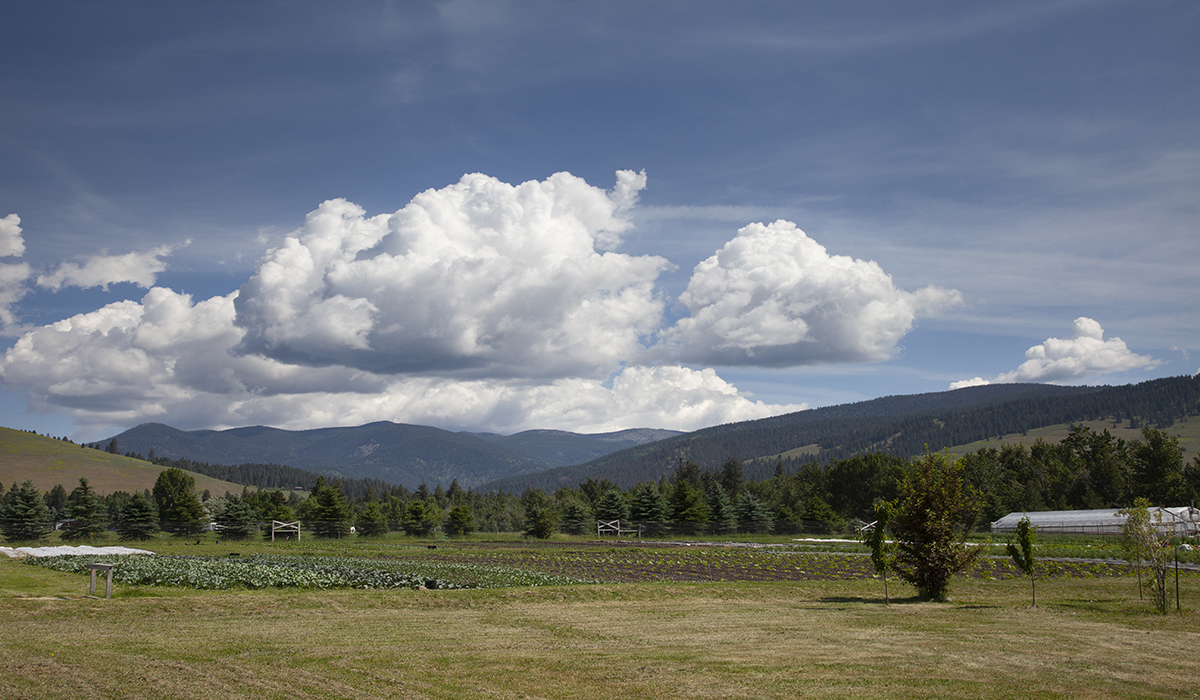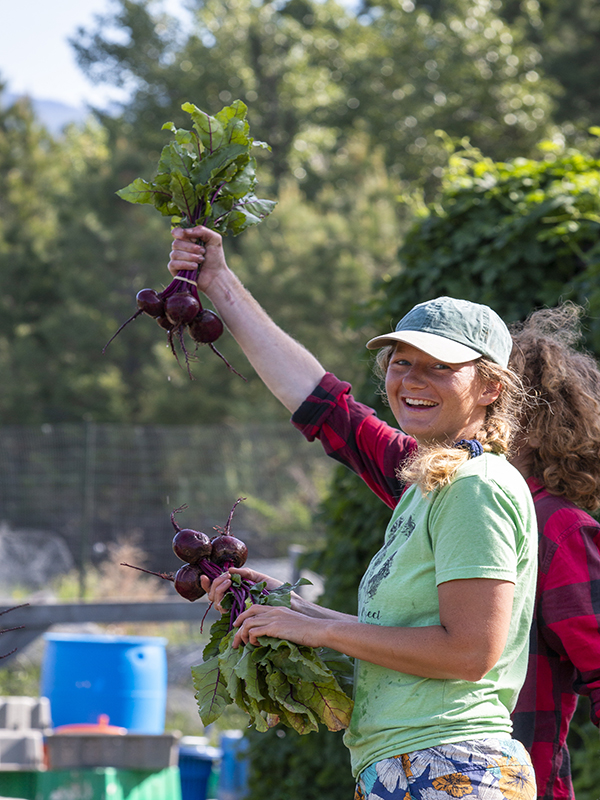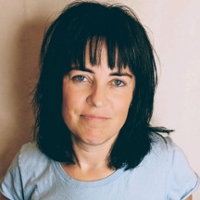- Editorial Offices
- 203 Brantly Hall
- Missoula, MT 59812
- (406) 243-2488
- themontanan@umontana.edu
From Kafka to Climate Change
Celebrating the impact of 50 years of environmental studies at UM.

Oh, the Humanities! A brief history of EVST
Still deep in the Vietnam War, the U.S. experienced a slew of monumental events in 1970, including the Kent State shootings, the Women’s Strike for Equality march and the occupation of Mount Rushmore by Native American activists. Also that year, Congress created the Environmental Protection Agency, 20 million Americans celebrated the first Earth Day, and, in Missoula, the University of Montana accepted its first graduate students into a new, highly relevant, curiously experimental academic program called environmental studies — EVST for short.
That program, now celebrating its 50th anniversary and 1,600 graduates, has gone through a multitude of changes. Still, EVST remains unique: a pro-active educational ecosystem that combines hands-on learning, interdisciplinary academic research, civic engagement, an unwavering attitude toward creative problem-solving and a belief that, with the right tools, a person can change the world for the better.
Ron Erickson, a UM professor of chemistry at the time, was one of the founding members of the program, along with faculty from a wide range of the University’s departments, including economics, geography, geology and biology.
Erickson says several factors led him to the conviction that an environmental program at UM was vital. A few years prior to its launch, the Western Montana Scientists Committee for Public Information, a group created by Missoula scientists, doctors and professors, began to speak out about issues like underground nuclear testing and environmental destruction. On campus, those same professors were finding opportunities to collaborate out of passion rather than for pay.
And, the Vietnam War and the environment played heavy on Erickson’s mind. “I basically became radicalized by the war,” he says, “and then made the discovery about environmental issues through people on campus and by reading a lot.”
He also recently had stepped outside of his usual chemistry realm to start teaching classes in UM’s College of Humanities, where he and the students analyzed Kafka and Homer.
“As a chemist it wasn’t obvious to do that, but it sounded interesting,” he says. “What that gave me was some perspective.”
When the group of faculty came together in January 1970, they had a vision for an environmental studies program that brought humanities and science together. They proposed it to John Stewart, a chemist and the newly appointed dean of the Graduate School, who readily approved it. It was a quick start: They enrolled the first graduate students that fall, and in the first couple years obtained grant money to start an environmental studies library and a lecture series that would bring in renowned speakers from all over the country.
“When we started EVST, we wanted to make a difference, and we knew that any kind of environmental program had to be amazingly cross-disciplinary,” Erickson says. “For myself, what I’m happiest about, is that humanities had to be a part of it.”
This year, in the middle of a massive pandemic, pitted against a federal administration that has systematically stripped away environmental protections and gutted the EPA, the EVST program’s creative approach and philosophy is more vital – and inspiring – than ever.
Hard-working romantics
From the beginning, EVST has been a program that seeks students who aren’t just looking for a job, they’re looking for purpose. It attracts people who have ambitious ideas and aren’t afraid to pursue them.
“These students are bright, eager, idealistic,” says Tom Roy, who became EVST director after Erickson. “They are romantics in the sense that they believe they can make a difference.”
EVST now offers both a graduate and undergraduate degree, plus a minor and certificates taught by award-winning instructors. There are some core classes students take, but beyond that, it’s up to the student how they want to design their education.
The Environmental Writing program actually came out of a cohort of students looking to dig into nature writing. Roy recalls setting them up for a self-directed class in 1992, out of which came a magazine, Camas: The Nature of the West, which is still run by EVST students today. Now the writing program has a reading series and the Environmental Writing Institute in which students take classes from top visiting environmental writers – a list that has included David James Duncan and Terry Tempest Williams. Every year, students publish essays and books from the work they do in the writing program.
Students don’t always know what direction EVST will take them. Alumnus David Glaser’s initial pursuit was in stream restoration, but even back then, in 1998, he had a feeling that economic disparity was a hindrance to environmental stewardship. Now, as director of Missoula’s MoFi, he helps provide flexible, responsible capital to people left out of the financial mainstream. As Missoula’s economy struggles during the pandemic, Glaser leans on what he learned in EVST, knowing that how a community and its environment flourishes depends on financial security – and that solutions aren’t always perfectly defined.
He recalls being frustrated getting conflicting feedback on his EVST thesis until his adviser, UM Professor Vicki Watson, told him, “David, it’s your thesis. You know when you’re done.”
“That lesson has parlayed itself very nicely into my professional career,” Glaser says. “You get something as good as it needs to be, but it won’t be perfect, nothing is perfect. And know that you own it. You own the solutions. EVST graduates are tackling all kinds of different societal issues with their background and experience, and I think it’s a real testament that it’s not a program that pigeonholes you.”
Alex Carr Johnson was living a nomadic life when he applied to the program in 2009. He had some background working on conservation projects, but he was interested in pursuing nature writing. During his time in EVST, he took a class with renowned author and visiting writer Rebecca Solnit. But when he received a Wyss Scholarship, which supports students committed to land conservation careers, his dream rerouted. He took classes in environmental law, science and conservation, and after graduation he served as the director of the Western Slope Conservation Center in Colorado and more recently became program director for the National Conservation and Parks Association in Anchorage, Alaska.
His love for writing didn’t go unquenched: A new anthology called “Earthly Love” recently published his essay “How to Queer Ecology,” whose origins were in the EVST writing class. Meanwhile, he’s on the frontlines of a battle for Alaska’s wildest lands. Johnson says the state moved $35 million meant for small - and medium-sized businesses during the pandemic to allow a private international company to build a road through the Western Arctic Corridor where 25,000 caribou migrate each year.
“In exchange for a couple hundred jobs that may or may not be employing people from the region, we are now threatening this living landscape stewarded for time immemorial,” Johnson says. “In less than 40 hours we got 100 Alaskans on the phones opposing it. This work has been wild but so meaningful. And EVST has prepared me for that.”
EVST has been a wildly successful incubator for leaders. In 1993, one EVST student, Bryony Schwan, helped give women activists a voice in the program and, consequently, on a national scale.
Schwan, who received an undergraduate education in Zimbabwe, was taking classes in water quality and ecology when she saw the way white male viewpoints were dominating the conversation. With the help of her EVST professors, Schwan launched a conference for women in 1994 on gender, justice and the environment. What she found is that you can’t fully talk about things like population or pollution without also talking about women’s rights.
The next year Schwan started Women’s Voices for the Earth, an organization that looks at environmental issues through the lens of women’s issues and gives voice to ordinary citizens who have a stake in problems like roadside spraying and mining. Eventually WVE began engaging with national environmental groups around public policy and spearheading campaigns on clean cosmetics and cleaning products. Throughout its lifespan, the organization has been staffed by EVST graduates, including its current director of science and research, Alexandra Gorman Scranton.
“So many of our staff ended up coming from EVST because I would take on interns,” Schwan says. “I never would have started it without EVST. EVST gave me the framework to be able to do it.”
It’s almost a joke among graduates that you can barely take a step in Missoula without running into a former EVST student working on an innovative project or launching a creative business. If it has an air of humanitarian and environmental value, there’s almost always an EVSTer involved.
Graduates started Home Resource, Ecology Project International, Lake Missoula Tea Company, Wild Rockies Field Institute and Indigenous Vision. Beyond Missoula, EVSTers have gone on to work for national environmental organizations and National Geographic, and they’ve started highly successful YouTube empires. A lot of times, they’re behind the scenes working on policy or in classrooms, teaching young students to value the delicate balance between nature and society.
“They don’t always get the headlines,” says current EVST director Dan Spencer. “But they are doing that important work below the surface that makes that kind of social change possible.”
“A whole belt of keys”
The experimental beginning of the EVST program mirrored the raw energy of the early environmental movement. Students floated the river, collecting samples to gauge local water pollution. The program procured equipment for a grad student so he could measure carbon monoxide levels and show a violation of air-quality standards at Malfunction Junction, an infamous, now-rerouted intersection of Missoula’s Brooks Street. Erickson, the director who later served in the Montana Legislature, recalls that one of the program’s co-founders said they were doing “up-against-the-wall ecology,” meaning studies that aimed to fight against ecological destruction.
Missoula had been listed in Time magazine as one of the most polluted valleys in the nation, due to woodsmoke and the pulp mill, so EVST classes focused on subjects like biological effects of air pollution. Students learned the science, policy, history, literature and philosophy around environmental issues. They went out into the community and to the capitol to push for legislative change.
Roy took over the program in 1984 when Erickson went on sabbatical. A professor in the social work department, Roy didn’t have an ecology background – he had history and philosophy degrees and had gone to Harvard for divinity school. But he had a reputation for understanding how to organize and build nonprofits, and he was known for being passionate about social issues.
During his tenure as director, the environmental movement was shifting from Earth First-style tactics to coalition building and collaboration. The idea that stakeholders might work together toward a common goal – even if their ideologies are different – began to take root in the program, too. And Roy got a taste for that shift, firsthand.
In 2003, as the Legislature was wrapping up the state budget, a conservative legislator introduced a bill to defund the environmental studies program. It didn’t pass, but it did concern Roy and other EVST instructors. So much so, in fact, that Roy ended up in a hostile meeting with eight legislators, some lobbyists, UM’s President George Dennison and a facilitator.
Afterward, as Roy sat by himself eating lunch, he met the quiet rancher from Big Timber, Sen. John Esp, who had introduced the bill to cut EVST. Esp said to Roy, “You don’t know what it’s like to live in a rural resource-dependent community.’”
Roy was deflated, but he thought about it and he said, “You know, you’re right. I don’t probably know.” And Esp said, “Why don’t you bring some students to Big Timber.”
That relationship between Esp and the EVST program lasted 10 years, with Roy taking at least a dozen students to Esp’s ranch each year. They toured mines, met with loggers and other ranchers, listened to their stories.
The Big Timber trip offered a forum for conversation and a space for everyone to recognize some common ground. One cattle owner who had initially referred to the EVSTers as “eco-terrorists,” eventually told Roy that he looked forward to the EVST students showing up more than almost anything else.
“It was the most interesting experience I had in EVST,” Roy says. “It broke down stereotypes.”
Len Broberg, EVST director after Roy, says the program allows for an edgy, experimental approach. In fact, it requires it. When it comes to big problems like land management, food systems and climate change (to name a few), solutions for environmental sustainability can seem mercurial — a moving target.
“You can’t keep using the same key to open all doors,” Broberg says. “You have to have a whole belt of keys. This program gives students the mental flexibility to be able to switch course when something isn’t working and find the right combination that will improve the situation. That’s what a good interdisciplinary, generalist education does. I think that’s the important part of dealing with crisis.”
The future
In his environmental classic “Sand County Almanac,” Aldo Leopold wrote, “One of the penalties of an ecological education is that one lives alone in a world of wounds … An ecologist must either harden his shell and make believe that the consequences of science are none of his business, or he must be the doctor who sees the marks of death in a community that believes itself well and does not want to be told otherwise.”
Earth Day and the EPA came about because the American public finally saw the environmental destruction around them – and they wanted to see it fixed. EVST answered that call to action with a successful program that continues to graduate leaders who, rather than living alone in a world of wounds, are part of a vanguard working toward positive changes together.
The face of EVST continues to change with the times. One of the most recent additions to the program is the Indigenous Knowledge and Environmental Sustainability focus led by Associate Professor Rosalyn LaPier, which combines traditional ecological knowledge (TEK) and Western environmental sciences.
LaPier helped initiate the first national March for Science and has brought missing pieces of knowledge from indigenous scientists into environmental academia. Souta Calling Last (Blackfeet/Blood), a Roddenberry Fellow, graduated from EVST and founded Indigenous Vision, for which she’s developed interactive mapping and educational tools for virtual reclamation of indigenous land. EVST graduate Hank Green, produces world-renowned environmental education, like “SciShow”, which has 6 million followers. In his bestselling 2018 novel, “An Absolutely Remarkable Thing,” he thanks the EVST program’s Phil Condon for inspiring him to write.
This spring marks the 12th anniversary of a major environmental restoration event on the outskirts of Missoula – the removal of the Milltown Dam on the Clark Fork and the 100-year accumulation of mining waste that had built up behind it. The removal and restoration of the confluence was spearheaded by the Clark Fork Coalition, a nonprofit directed at the time by an EVST grad Tracy Stone-Manning and staffed by other EVSTers. Professors in the program used the cleanup as an education tool.
UM Professor Emeritus Watson is EVST’s longest serving faculty member (37 years). Hired in 1983, she arrived at UM just as the Clark Fork River Superfund sites were declared and as a large pulp mill near Missoula proposed increasing discharge to the river.
She soon recognized that the Clark Fork watershed suffered from many additional problems. Working with hundreds of students over the years, she established the UM Watershed Health Clinic and helped start and sustain many watershed groups that have made great strides in restoring and conserving western Montana’s watershed. Watson and her students also helped develop some of the country’s first water quality standards, and many program alumni now work forgovernment agencies and watershed groups all around the U.S.
Years later, the Clark Fork River has become an artery of Missoula again, and the Milltown Dam area sports a beautiful state park — the ranger, Mike Kustudia, is an EVST grad, of course.
The holistic view that indigenous scientists understood, and the concern Leopold addresses when he talks about the disconnect between ecologists and everyday people, is at the foundation of EVST’s story. The solutions for these issues – dam removal, climate change, the current pandemic – require science and humanities approaches to be successful.
“Science alone cannot convince people to change their habits or to enact policies that require funding and sacrifice,” Watson says. “It requires good communication skills and a knowledge of policy and how to change the system. You need natural and social sciences and all of the humanities to create positive change.”
Food in the time of COVID-19
 In the late 1990s, the EVST program started focusing on farming and food issues — an area of study that was often ignored in environmental academia. In 1996, however, Josh Slotnick, a graduate of Cornell and a Missoula farmer, proposed a student-run farm to EVST that would offer educational opportunities and help supply the food bank and WIC program with fresh vegetables. Slotnick and other community leaders secured $150,000 to start Garden City Harvest, and the 10-acre Program in Ecological Agriculture and Society (PEAS) Farm was born. In 2000, EVST hired Neva Hassanein, a professor in food policy, who helped push PEAS further into the spotlight and advocated for a food policy emphasis in the EVST program just as local food was becoming a hot topic nationwide.
In the late 1990s, the EVST program started focusing on farming and food issues — an area of study that was often ignored in environmental academia. In 1996, however, Josh Slotnick, a graduate of Cornell and a Missoula farmer, proposed a student-run farm to EVST that would offer educational opportunities and help supply the food bank and WIC program with fresh vegetables. Slotnick and other community leaders secured $150,000 to start Garden City Harvest, and the 10-acre Program in Ecological Agriculture and Society (PEAS) Farm was born. In 2000, EVST hired Neva Hassanein, a professor in food policy, who helped push PEAS further into the spotlight and advocated for a food policy emphasis in the EVST program just as local food was becoming a hot topic nationwide.
At conferences across the country, Slotnick says, the PEAS farm and local food emphasis has been a model, and it has touched off similar programs since then. It provides 15,000 pounds of fruit and vegetables to the Missoula Food Bank and offers 100 Community Supported Agriculture shares to the community.
In 2018, Slotnick left his EVST post to become a Missoula County commissioner, and EVST alums Caroline Stephens and Dave Victor have split his role.
“Our primary goal is to maintain this amazing program we’ve inherited,” Stephens says. “The bones of it are
so good.”
The food and agriculture emphasis in EVST is a shining example of the many areas of focus within the program. Hassanein’s classes investigate food systems and explore the intellectual questions around them. Meanwhile, students at the PEAS Farm learn to grow food with sustainable practices, collect data and share it with other agricultural communities and get to be part of their own little community on the farm.
The hands-on work at the PEAS Farm has had to shift in the COVID-19 pandemic, and Stephens says they’ve had to adjust to the change. But it’s also illuminated the way EVST students and faculty respond to crisis. When the Missoula Food Bank and grocery shelves seemed bare, EVST students and faculty were on social media brainstorming ways to get fresh local food to people in the community. That’s just what they do.
The public service itch
The Big Timber trip ended when Tom Roy retired, but that idea of understanding diverse viewpoints to obtain environmental goals didn’t die out. One graduate, Zach Brown, has served three terms in the Montana Legislature all because of the interest he developed in EVST for working across the aisle in local politics. Brown was like a lot of EVST students: curious, idealistic and a risk taker. In 2009, during his first year in the program, he heard about an opportunity to apply to a climate summit in Copenhagen, Denmark. His adviser, Dan Spencer, said he should apply but warned him that as an inexperienced 18-year-old, he probably wouldn’t get in.
And he didn’t. But Brown decided he wanted to get a sponsorship and go anyway and, seeing his determination, Spencer decided to help him make it happen.
Brown naively imagined the summit as a place where he could participate in deliberations and make an impact, but he says, it ended up being him in a sea of 30,000 wandering around a convention center. Yet the experience got him thinking about what he could do on a local level.
He came back to UM and started meeting with the campus climate group. As a sophomore he put on a convention, and he talked with public officials Montana Gov. Steve Bullock and former U.S. Congressman Ryan Zinke about state level policy. By the time 2014 rolled around, Zach was asked to run for the Legislature.
“There’s a really important place for people who are thinking about massive systems and global cooperation,” he says. “But if I can meet with a senator and build a relationship, that scale of change feels more tangible to me. When I started thinking that way, it became addictive. I don’t need to be the ambassador to the U.N.
There are projects everywhere in a community that need people to take them on and make things better. And because EVST was supportive of my endeavors, that gave me an itch for public service that hasn’t worn off yet.”

Story by : Erika Fredrickson
Erika Fredrickson is a freelance journalist based in Missoula. She graduated from UM’s Creative Writing Program in 1999 and earned a master’s degree in environmental studies in 2009.




